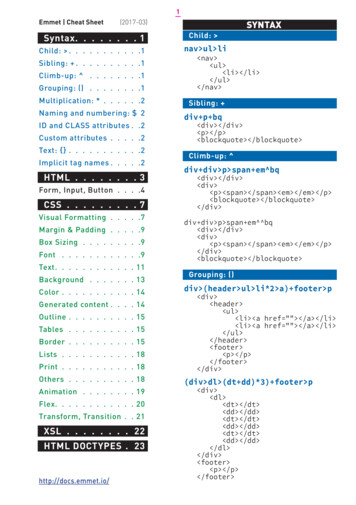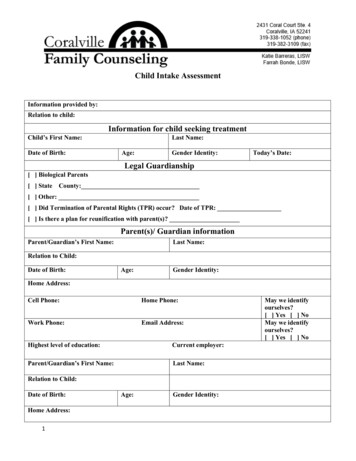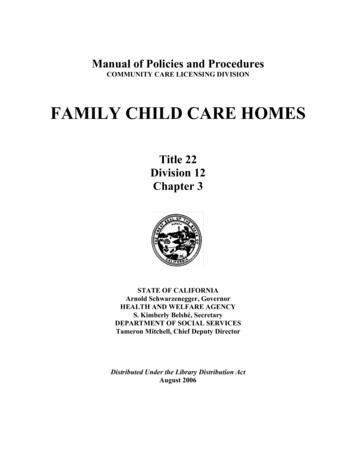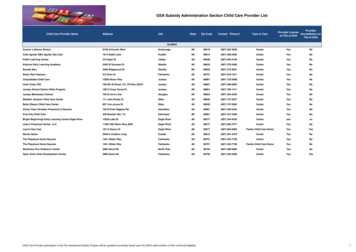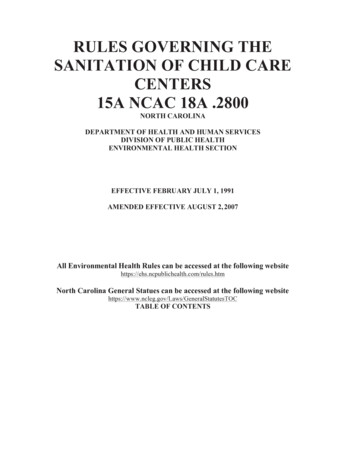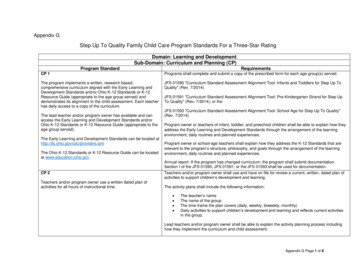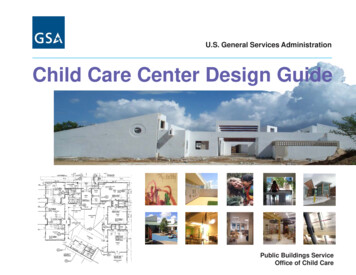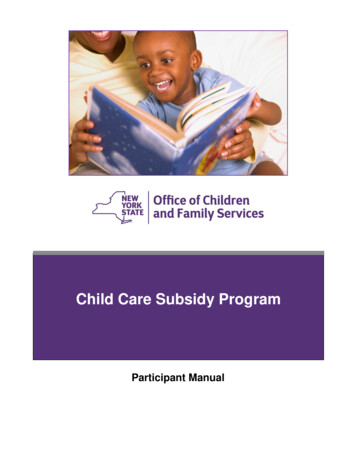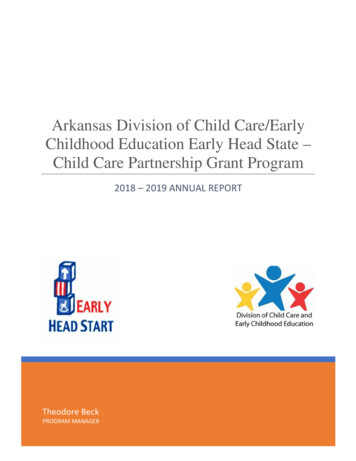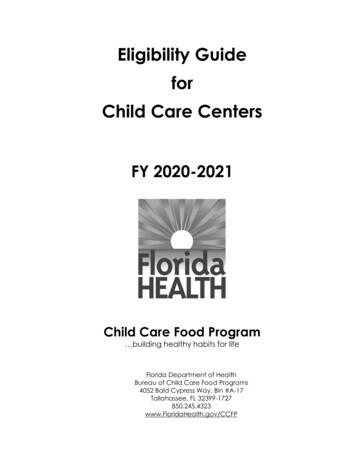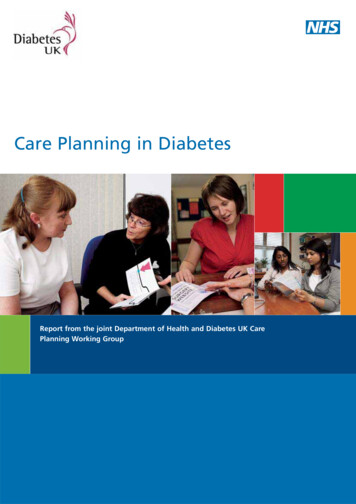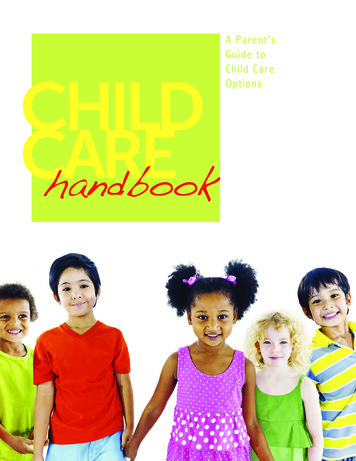
Transcription
CHILDCAREhandbookA Par ent’sGuide toChild Car eOptions
Stevenson, K. (2014). Child care handbook. (A. Moyer, Ed.). Raleigh, NC:Workplace Options.Copyright 2015 by Workplace Options
CHILDCAREhandbookTable of ContentsIntroduction 5Defning Your Parenting Style 6Quality Care Environment 6Changes From the Obama Administration 8Types of Care 8Breaking It Down 10Nannies.10Au Pairs .11Relative Care.12Mother’s Helpers. 12Family Day Care Homes . 13On-Site Day Care Centers. 13Day Care Centers . 14Part-Day Programs. 14Early Intervention. 15Cooperative Care. 15School-Age Care. 16Summer Care. 16Pros and Cons of Each Type of Care 18Special Circumstances 20Sick Days.20Special Needs. 21Behavioral Difficulties. 21Learning Disabilities. 22Physical Challenges. 22Amount of Care 22Child Safety 23Ages of Children 23
CHILDCAREhandbookReviewing Provider Parameters 25Measuring Cost 25Financial Assistance 26Cost-Reduction Strategies. 26Tax-Based Subsidies. 28Public Subsidies. 28Loans, Scholarships, and Grants . 28National Resources. 28Work-Life Balance 29Preparing Yourself 29Preparing Your Child 30Having a Backup Plan 31Going the Distance 32Choosing Child Care Checklist 33Parent Resources 35
CHILDCAREhandbookIntroductionParenthood is a wonderful thing! If you are a first-time parent, you may beoverwhelmed by your love for your newborn, your newfound responsibilities, minimalhours of sleep, and your task of finding a quality care environment for your child whenthe time comes for you to return to work. If you’ve done this before, you know thatidentifying your family’s needs and choosing the right child care is important to thehappiness of your family and a successful return to work.The good news is that many parents are very satisfied with their current child carearrangements.With many child care options available, which is right for you and yourfamily?If you’re starting from square one, it’s important to first identifyyour family’s needs. Ask yourself these important questions:1Depending upon the age of your child, what type of care do you want?Consider your own parenting style and philosophies of how your childshould be cared for.2How much care do you need? Take a hard look at your schedule,your commute, your resources, and your finances when considering totalhours per week needed.Seasoned parents should also take the above questions into consideration. If yourchildren are different ages, will a single source be the best fit, or do you prefer acombination of age-appropriate options (which could mean two different providers)?Whether you are moving from a stay-at-home situation to a care provider,seeking care for a new arrival, or adding a sibling to existing care, carefulresearch should be done on how the change will impact your family andyour bottom line.CHILDCARE HANDBOOK · 5
Defning YourParenting StyleThe primary objective of your search isultimately to find someone you trust to carefor your child.With a clear sense of your ownparenting style, you’ll be better equipped to findthe right caregiver: one who shares your viewson taking care of children.If possible, both parents should sit down andoutline a list of preferences, absolute dealbreakers, and areas of compromise.This will beyour game plan and help you to identify theskills you’re looking for when creating interviewquestions, calendars, and checklists.Here’s a list of fundamental action items to getyou started on choosing a provider.You can addto or remove items from this list to tailor thequestions to your specific situation: How does the caregiver soothe a cryingbaby? Is he or she certified in first aid and infantCPR and choking? Is a religion-based environment an issue ora preference? This includes those who praybefore a meal, recognize religious holidays,and so on. What is your provider’s policy on breastfeeding? How much television is your child allowed?What kinds of shows? Is it acceptable for your child to berewarded with treats? How should your child be praised? Howshould he or she be disciplined? Does your child have health issues orneeds that require special attention? Is your provider in good health? Doeshe or she smoke? What is the provider’s visitation policyduring the workday?6 · CHILDCARE HANDBOOKWhile each environment is different and youwill not be able to anticipate every situationthat may arise, get your overall views on paper.Knowing what’s really important to you asa parent will help you identify a child careprovider you can trust. In addition to assessingyour parenting philosophy, you may also wantto assemble a list of traits you feel a qualitycaregiver should have. Later, when meeting withproviders face-to-face, this established outline ofyour ideal caregiver coupled with your maternalor paternal instinct will make the task of findingthe right fit much clearer.Quality CareEnvironmentNot all children are the same; they each havetheir own distinct needs. In much the sameway, child care facilities can vary widely. Sowhat is a quality care environment? Licensedday care centers are strictly regulated by stategovernments, but your child’s care should beevaluated in terms of specific individuals as wellas the environment they provide. Make surethe provider’s focus is on the children. Firstimpressions can be key.What is your reactionwhen you walk in the door for the first time? Ifyou have a sense of comfort and security, yourchild likely will too. All rooms should be cleanand inviting, but not sterile.This is a place of play,after all. But be sure to inspect for safety, bothindoors and out. Any unsafe areas (kitchens,pools, and anywhere chemicals or cleansersare stored) should be restricted or carefullymonitored.
Take a look at ratios and group sizes.Depending upon age, there are staterecommended ratios and maximum sizes foroptimal levels of care.Weigh the number ofchildren to staff members to be sure the centercomplies with these regulations.Children and caregivers should have a goodrapport, with the adults clearly in control. Dothe caregivers have smiles on their faces? Arethey down at the child’s level? Do they speakkindly when assisting or giving instruction?Caregivers should be alert, aware, attentive, andrespond quickly in all situations. Look, too, atthe children’s faces to see if they’re happy.Child development opportunities come in awide selection of activities, with a balance offree play and structured learning. Childrenshould be challenged by age-appropriatematerials, encouraged to learn and be creative,and have fresh air with outside playtimewhenever the weather allows.accredited or in the process of becoming so?What about employee turnover? The continuityof your child’s care is key to his or her positivedevelopment, and a high rate of turnover couldbe a red flag. After your initial visit, drop inunannounced to observe. It is recommendedthat you visit each location a couple of timesbefore involving your child in further evaluation.It is important for parents to realize that whatworks for your neighbor may not be whatworks for you.The environment you seekfor your children should be tailored to yourfamily’s needs, your budget, and any number ofextenuating circumstances.Your requirementsmay also change as your children grow, so don’tfeel as though you need to be locked in to oneprovider. Evaluate all avenues available to you,and make your selection based on the best fitfor your children.Ask for descriptions of meal and nap times,and note whether food is supplied by youor the provider.This is also a good time tomention special dietary restrictions.The Childand Adult Care Food Program (CACFP), e-food-program, may be available in daycare centers, family day care homes, and someafter-school programs. Caregivers shouldinteract with children during meals and providea comfortable and quiet area for napping.Ideally, caregiver qualifications and experienceshould include early childhood educationtraining or credentials. During the interviewprocess, ask open-ended questions like,“Whydo you like caring for children?”The answerswill tell you much about the environment. Muchlike checking an individual caregiver’s references,you can also ask about a center’s history andcheck for parent complaints. Is the centerCHILDCARE HANDBOOK · 7
Changes From theObama AdministrationEarly care and education is a very laborintensive industry. Despite the fact that childcare is one of the lowest paying professionalfields, up to 80% of the cost in a providerprogram is for payroll and payroll-relatedexpenses.1The United States is the only industrializednation that doesn’t require employers to givepaid maternity leave for the birth or adoptionof a child.The U.S. Department of Labor’sFamily and Medical Leave Act allows for 12unpaid weeks of leave during a 1-year periodto care for a newborn or seriously ill familymember.The Act does not, however, coverpart-time workers and those at companies withfewer than 50 employees.This prompts manyto return to work as soon as possible, meaningthat child care spots fill quickly.Child care in the United States is expensive andthe costs are getting higher. Child care is a majorexpense in family budgets, often exceeding thecost of housing, college tuition, transportation,or food. Unlike all other areas of educationinvestment, including higher education, familiespay the majority of costs for early education.These expenses come at a time when youngfamilies can least afford them.2Teachers with strong professional preparationare essential to providing a high-quality earlylearning program, as adult-child interactionsare the most powerful predictors ofchildren’s development and learning.It is therefore essential that federal1 Fraga, L. M. (2013). From the executive director. In Child Care Awareof America, Parents and the high cost of child care: 2013 report. RetrievedApril 29, 2014, from http://usa.childcareaware.org/2 Glynn, S. J., Farrell, J., and Wu, N. (2013, May 8). The importance ofpreschool and child care for working mothers. Retrieved April 29, 2014,from http://www.americanprogress.org/8 · CHILDCARE HANDBOOKand state governments help families access andafford quality child care so that children’s safetyand healthy development are not jeopardized.To that end, President Barack Obama made ahistoric pledge in his 2013 State of the Unionaddress to provide universal, high-qualityprekindergarten education to the childrenof this nation. His fiscal year 2014 budgetproposal included universal preschool andplans to strengthen the quality of child carefor children from birth through age 3. Obamaseeks to allocate millions of dollars to expandpublic child care services, 15 billion over thenext decade to expand state home-visitationprograms to America’s most vulnerable families,and 75 billion over the following decade toinvest in expanding access to quality preschool.If you’d like to see the details broken down,watch President Obama’s Early LearningProposal Webinar at https://www.youtube.com/watch?v HdPicVEvW-c.Types of CareChild care options, for the most part, aredivided into two major categories: home careand center-based care. In-home care is definedas anyone coming to your residence to provideservice, such as a nanny, au pair, family member,friend, or mother’s helper. Family day carehomes, which are operated out of an individual’shome, usually have one primary caregiver andperhaps an assistant.Center-based care is either an on-site or offsite center that employs a full staff of teachersor caregivers. As your child grows, part-day
programs, preschools, and early interventionoptions (such as Head Start and state-specificprograms) would also fall under this category.For older children, before- and after-schoolas well as track-out care and summer campswould also be considered center-based.Depending upon the number of hours youneed, co-ops (or cooperatives) are a third optionthat work well for some families. Co-ops aredefined as groups of parents who take turnscaring for one another’s children. Memberswatch someone else’s child to earn credits (orinstances or hours of care), and then redeemthose credits when they need a sitter of theirown.It’s recommended that you spend timecarefully investigating your child care options,beginning at least 6 months before you needit.When phone screening, look for pluses butalso be aware of minuses: gaps in a caregiver’semployment record, behavioral tendencies orextremes, or anything unusual or disconcerting.Use a checklist when interviewing candidatesand visiting centers.You can’t take any detailsfor granted, and you want to be able to keepyour options straight. After a few visits, some ofthe specifics might start to run together if youdon’t have a written record.Tailor your checklistto include things that are important toyou, for example, personality (neatness,mobile phone use, sports a caregivermay be able to play with your child);job requirements (light cleaning,laundry, homework, orprovider schedule);and security (drivingrecord or buildingaccess).This is agood opportunityto highlight thosepreferences, dealbreakers, and areasof compromise.From little thingslike meals, snacks, diapers, and wipes, to biggerissues like class ratios and staff training andqualifications, you’ll want to be able to reviewthe material again before making cuts anda final decision. Always ask for and checkreferences.What about terms like licensing, certification, andaccreditation? Each is a mechanism for applyingstandards to the profession of delivering childcare. Much like a star-rating system, however,they are not guarantees.When a day care center is licensed, it simplymeans that it has met the minimum standardsset forth by state law. Requirements differ fromstate to state, so learn your location’s standardsand ma
handbook. Introduction . Parenthood is a wonderful thing! If you are a first-time parent, you may be . service, such as a nanny, au pair, family member, friend, or mother’s helper. Family day care homes, which are operated out of an
